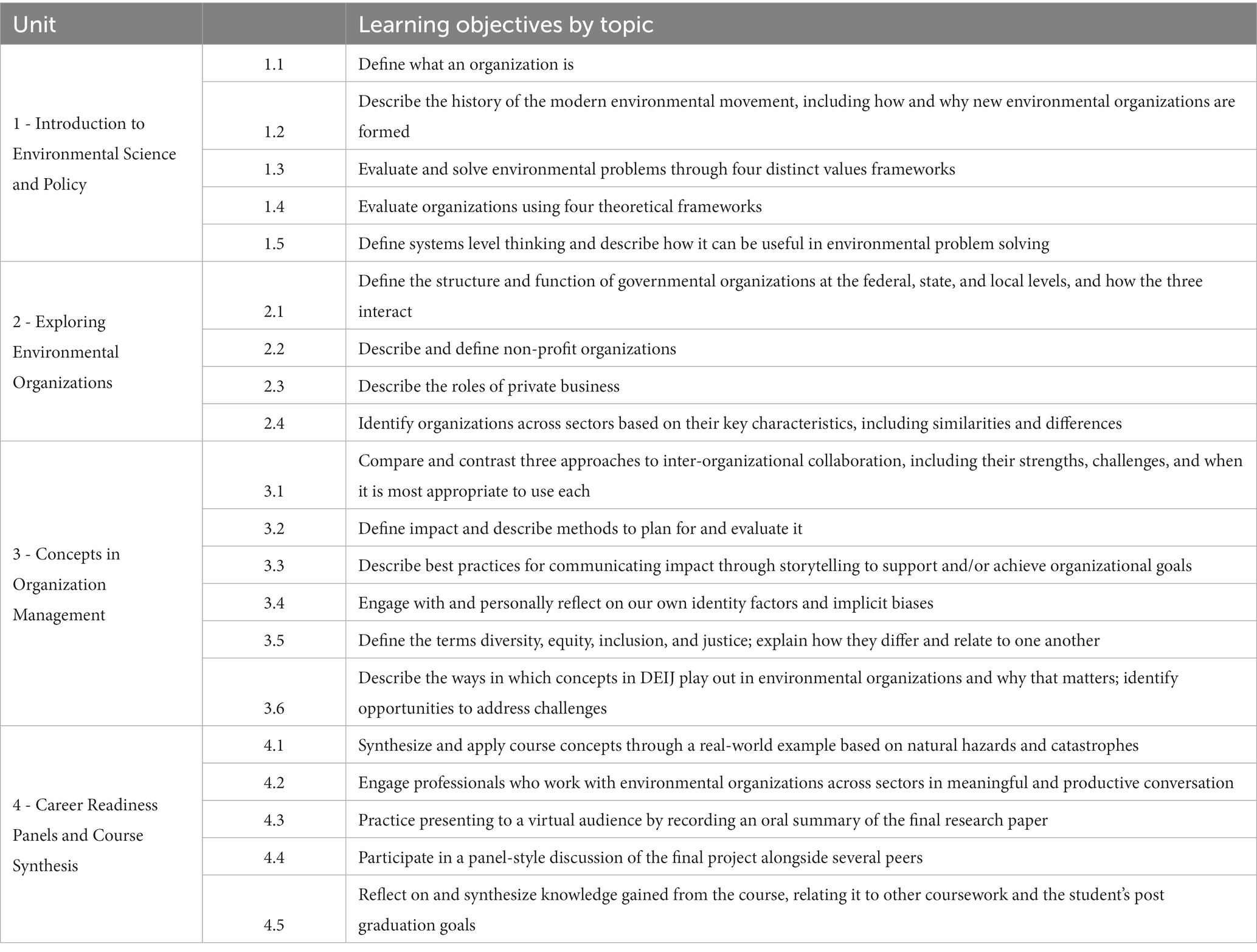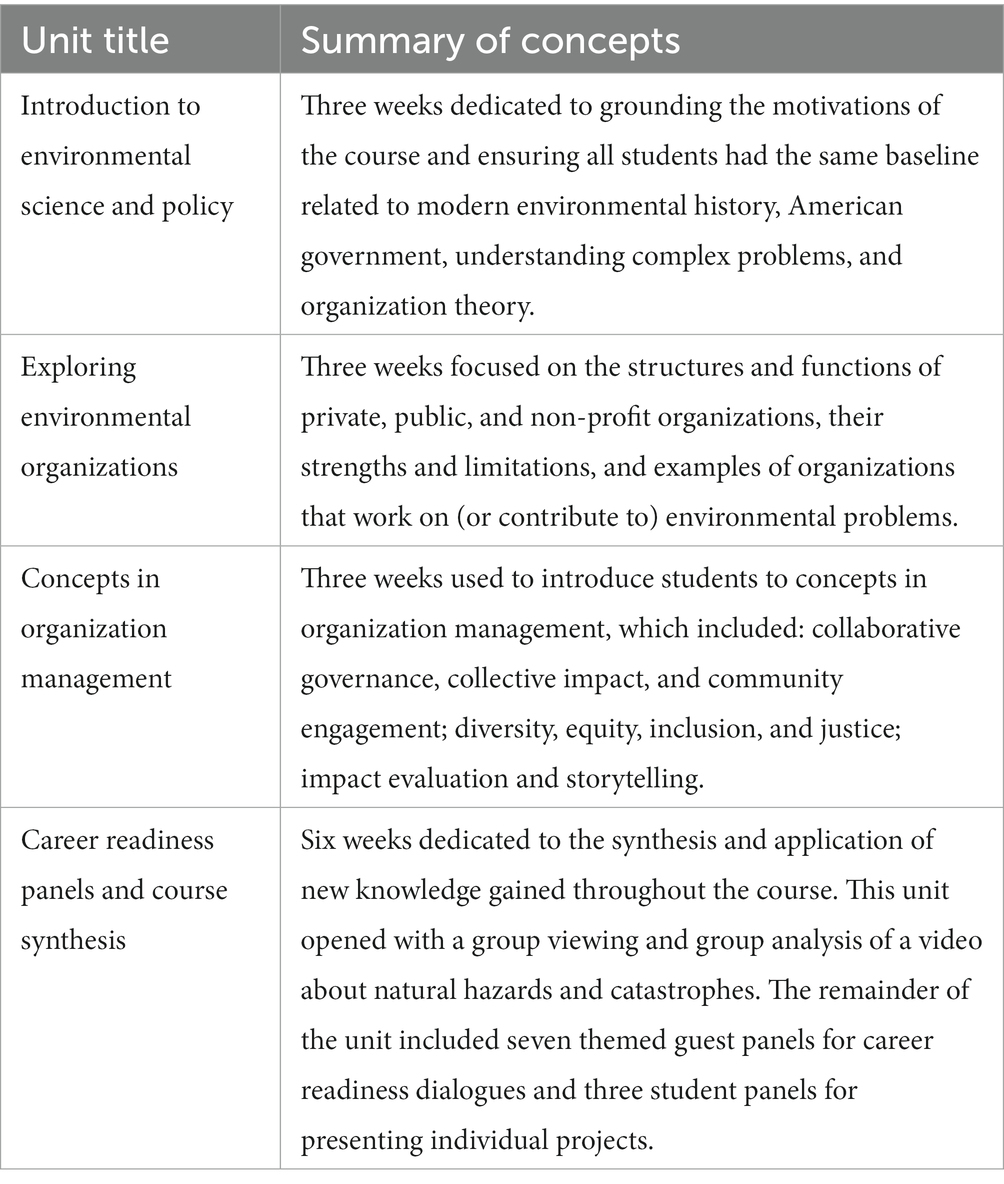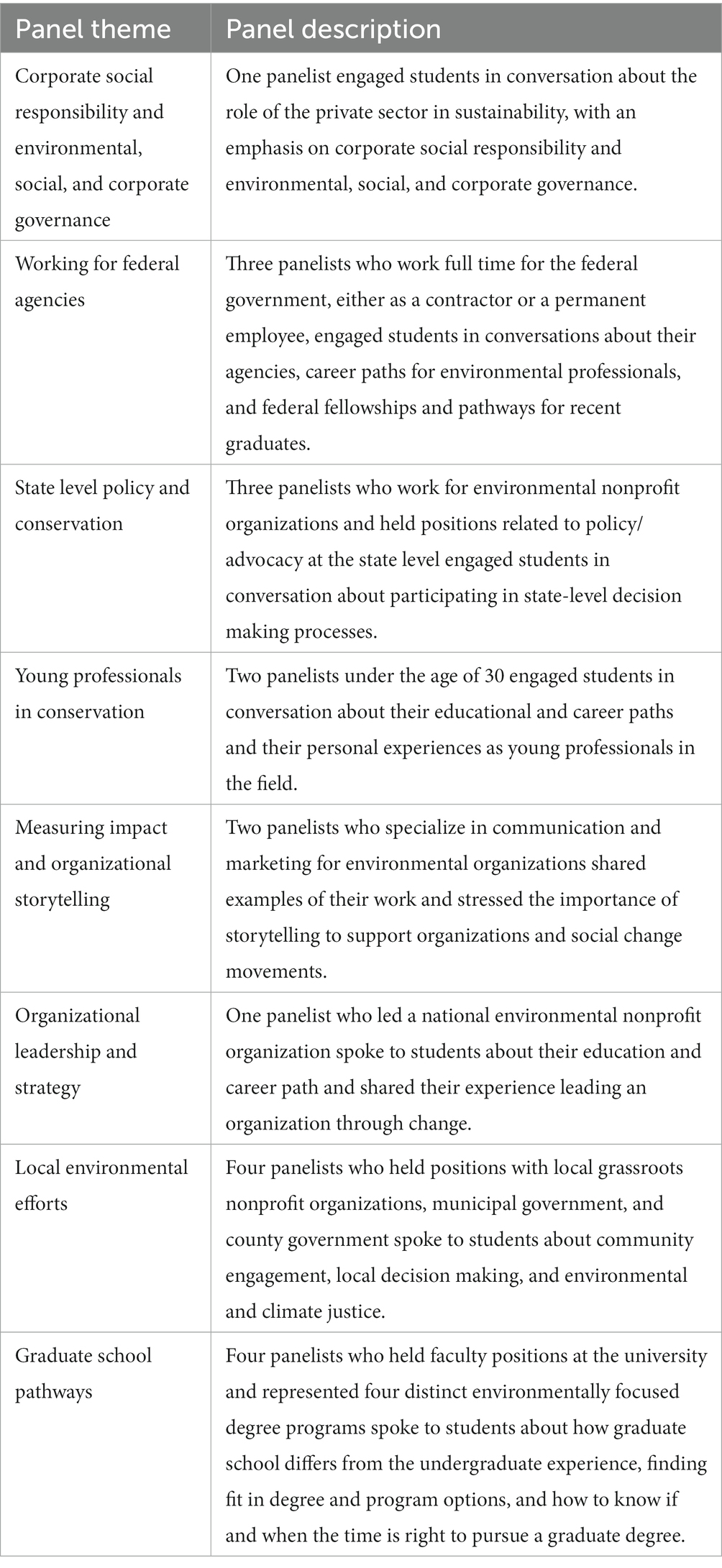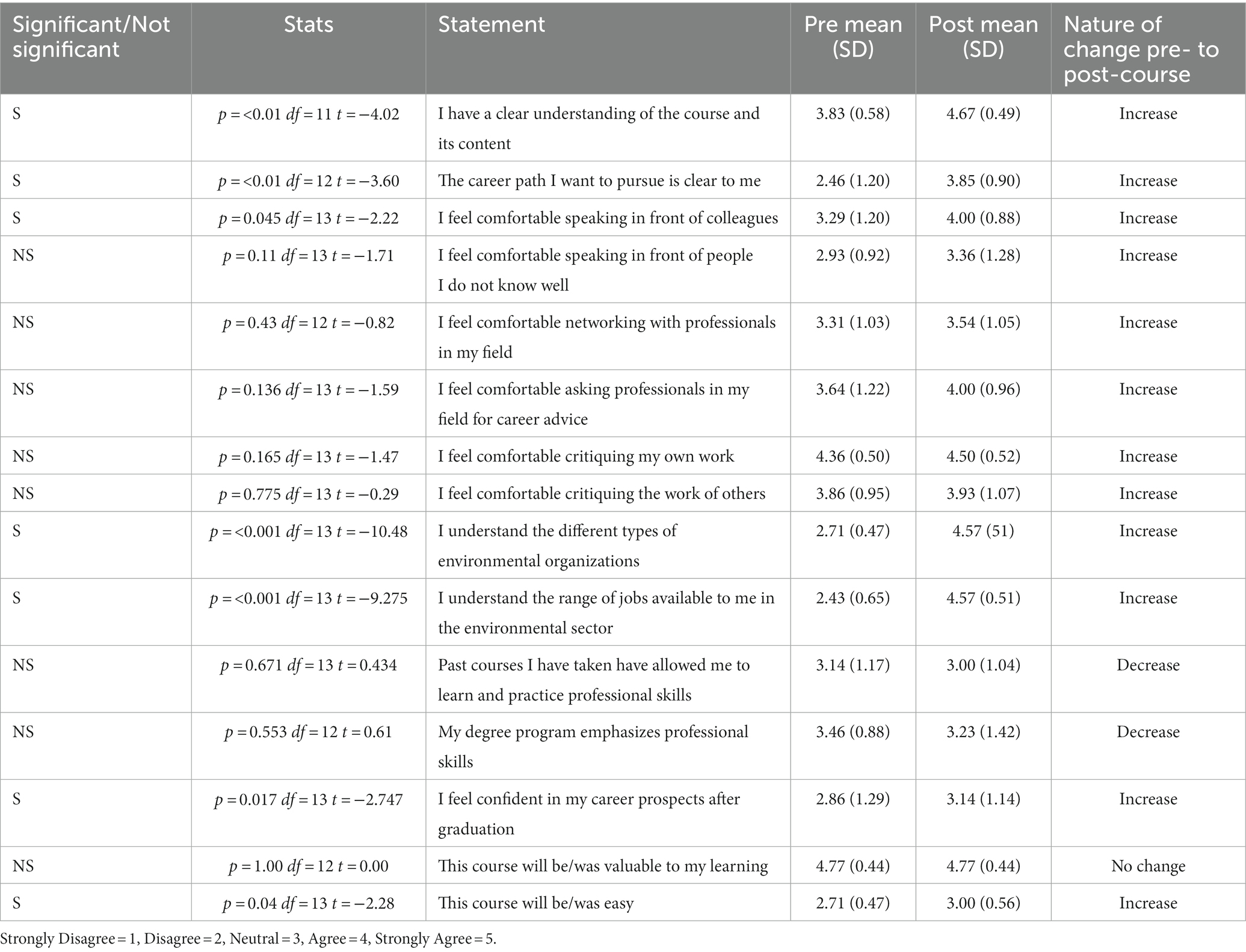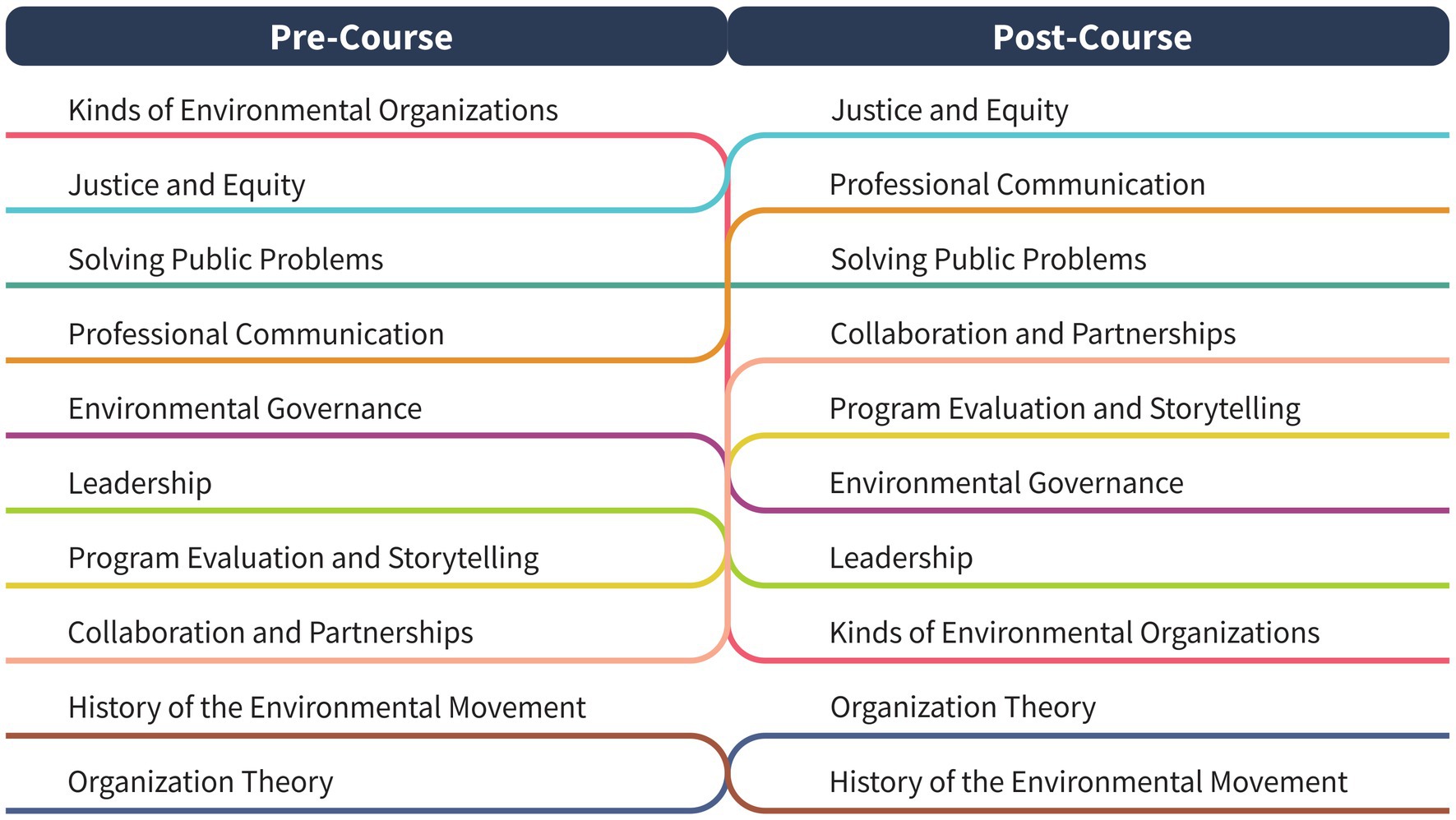- Department of Environmental Science and Policy, Rosenstiel School for Marine, Atmospheric, and Earth Science, University of Miami, Coral Gables, FL, United States
In the modern workforce, environmental scholars and professionals need a working technical knowledge of complex social-environmental issues and a mastery of interpersonal skills like leadership, communication, and collaboration. This article reflects on a special topics course offered to undergraduate students in Fall 2021, titled “Survey of Environmental Organizations.” Pre- and post-course surveys were given to assess student experiences and outcomes. Results of paired t-tests and open-ended responses show that students gained confidence in their career prospects, developed and practiced professional skills, and benefitted from opportunities to network with professionals in their desired field(s). The principal contribution is a framework for educators who may want to integrate professional skills and career readiness into courses or programs in environmental science.
Introduction
As the nearly 61 million members of Generation Z (Gen Z) in the United States (Dimock, 2019) reach working age and begin their careers, organizations and managers can expect significant shifts in the meaning of work and how it gets done (Schroth, 2019). Growing up through the global financial crisis in the early 2000s and the COVID-19 pandemic beginning in 2020, both periods of social and financial disruption, this generational cohort often experiences anxiety and other emotions related to the uncertainty surrounding their careers (LaGree et al., 2021). As a result of these historic events and cultural factors associated with their generational cohort, members of Gen Z hold their own expectations for the role of work in their lives (Iorgulescu, 2016) and increasingly question the role colleges and universities have in preparing them for the world of work (LaGree et al., 2021). Regardless, this cohort’s motivations for attending college appear no different than other generational cohorts – they want to acquire, practice, and master skills that will be of use in their professional lives (Seemiller and Grace, 2017). In the classroom, they want to know how concepts can be applied to the workplace (The Wiley Network, 2023), and in the workplace they want to know the work they are doing has meaning and that their employers share their values (Seemiller and Grace, 2017). They also express interest in using their knowledge and skills to do work that aligns with the causes they care about, including a range of social and environmental problems (Della Volpe, 2022).
Across industries, leaders in the workplace have expressed a great need for rising professionals who have mastery of both technical knowledge and interpersonal skills. In the environmental sector, there is a need for rising professionals to possess and master these skills in order to make change and address pressing and complex environmental challenges from the highly localized scale to the global (Newing, 2010; Fortuin et al., 2013; Langholz and Abeles, 2014). Many post-secondary courses that are focused on career readiness for STEM students and are represented in the literature focus on specific technical skills that are desirable in industry, such as GIS (Stewart, 2021), environmental communication (Akerlof et al., 2021), and fieldwork techniques (Stewart, 2021). Environmental educators have also set an agenda to increase emphases on transferable skills that prepare STEM students for the workplace (Mello and Wattret, 2021) and the development of non-scientific expertise such as systems level thinking and incorporating diversity, equity, inclusion, justice, and accessibility throughout the organizations that compose the field (Salazar et al., 2022). However, authors who have called for these skills as part of a curriculum have largely focused on graduate students (Bridgstock, 2009). There are opportunities to begin exposing younger students to these important skills and concepts, which includes undergraduate students and possibly later stage high school students.
In the fall semester of 2021, undergraduate students had the opportunity to take a special topics course titled “Survey of Environmental Organizations.” The author intentionally designed this course to help students develop their knowledge, skills, and confidence for post-graduate employability with environmental organizations in any sector. The course differs from those that have come before it by focusing on organizations in the field, their functions, and the skills that employees possess to help their employers carry out their missions, leaving flexibility to adjust coursework to suit students’ interests and needs and allow them room to explore areas of environmental science that may have been unfamiliar to them. The end goal was to prepare students to succeed in any career path they chose by providing a course that supplemented their more technical and theoretical coursework.
Since science coursework and careers already place heavy emphasis on and reward individual achievements (Nadkarni, 2004), the course was built upon the three important categories of critical interpersonal or soft skills identified by Langholz and Abeles (2014) as essential for future leaders in ocean science to possess: communication, collaboration, and innovation. To teach the skills future environmental professionals need to effectively address pressing environmental problems, course pedagogy mirrored the non-academic environmental workplace, emphasizing collaboration, communication, critical thinking, and innovation through multi-disciplinary learning (Blickley et al., 2013; Kivunja, 2014; Langholz and Abeles, 2014; Khanna, 2015; Kivunja, 2015; McGreavy et al., 2016). The course relied on dialogic pedagogies (Teo, 2019) and guided inquiry design (Heinström and Sormunen, 2019) to help students engage with readings, lectures, discussions, and each other in personally meaningful ways, while leaving room for learner-centered education that allowed students to explore environmental science topics and career paths that were personally relevant to them (Dole et al., 2016). Students were expected to have read assigned articles or chapters prior to class, which allowed for deeper conversations in the classroom that reinforced course concepts. Students were encouraged to bring examples from their personal experience or their other coursework that would be relevant to discussions as a way to illustrate concepts across a range of environmental topics and challenges. Reflection and journaling can also be effective at helping students synthesize and draw connections between important concepts and is often used in career counseling (Hampton and Morrow, 2003; McGuire et al., 2012; Woodbridge and Rust O'Beirne, 2017). For that reason, opportunities for individual and collective reflection were intentionally built into course discussions and assignments.
This case study summarizes the course and its content, its outcomes, and areas for change or improvement. The goal is to encourage or assist departments and instructors who wish to develop or implement professional-oriented education in their own environmental classrooms or degree programs.
Background
Course description
This interdisciplinary survey course bridges theory and practice, introducing students to the different types of organizations that conduct work related to the environment and sustainability. The course exposes students to concepts in organizational management and administration and prepares them for future careers with environmental organizations. Course structure includes lectures, discussion, and guest panels of professionals who work for different types of environmental organizations and in various capacities.
Course composition
Fourteen undergraduate students completed the course. Based on previously completed credit hours, one student entered the course a sophomore, seven were juniors, and six were seniors. Student majors included Environmental Science and Policy, Marine Science and Biology, Marine Affairs, Global Health, Meteorology, and Microbiology and Immunology. Four students were pursuing double majors and 10 had declared a minor. Seven students had previously completed an internship, fellowship, or had work experience with an environmental organization and seven had not. The course was offered in the fall semester of 2021 as the university returned to fully in-person instruction. Face coverings were always required in the classroom, but social distancing and testing requirements used in previous semesters were relaxed because of vaccination efforts.
Learning outcomes
Learning outcomes for the course were designed to help students understand the theoretical and applied nature of the course. Seven broad outcomes were listed in the course syllabus:
“By the end of this course students should be able to…
1. Read, analyze, and critique interdisciplinary scholarship and relate concepts from the literature to their area(s) of interest/expertise.
2. Demonstrate mastery of course concepts related to organizational types and interactions, organizational analysis using organization theory, and interpersonal skills that are essential in the modern environmental workplace.
3. Effectively communicate their own work for defined audiences across mediums, including oral, written, and visual.
4. Engage productively with diverse perspectives and individuals who work with environmental organizations.
5. Practice and model professional skills and behaviors in a classroom setting.
6. Establish or refine their professional goals using knowledge and relationships gained throughout the course.
7. Feel confident in their career readiness and ability to succeed in their post-graduate pursuits, whatever they may be.”
Table 1 lists the course’s four units and topic-specific learning objectives associated with each.
Course structure
Through readings, lectures, assignments, professional guest panels, and student projects, the course aimed to introduce students to concepts and skills relevant to environmental careers and help them develop their own post-graduate plans. To organize course information and milestones throughout the 15-week semester, content was presented across four units (Table 2). The course met twice weekly for 75 min each, and students received a pre-recorded introduction to each unit that was prepared by the instructor. The first unit of the course was designed to ensure students developed a shared baseline of knowledge before moving into the core content of the course in units two and three. Unit four challenged students to synthesize their new knowledge and draw connections between this course and others they had taken by engaging guest speakers, as well as completing and sharing an independent project of their choosing in a panel format.
Discussions, activities, and assignments
In-class activities and independent assignments assessed student mastery of course concepts (see Supplementary materials). Each was designed to create opportunities for students to practice the skills that they learned in class, to relate course concepts to their areas of interest and expertise, and to develop a portfolio of work to use in the future. Some assignments were more structured in their instructions and format, like a 500-word blog in response to one of several prompts, while others offered more flexibility for students to create work that aligned with their career interests. For example, one assignment allowed students to present their work using the medium or media of their choosing, which included submissions of written analyses, an infographic, recorded presentations, a strategic communications toolkit, and a strategic plan to achieve an organizational goal. For all independent assignments students received feedback from the instructor and were permitted to revise and resubmit their work to receive partial credit back on their original score. This approach created opportunities for students to receive constructive feedback, continue engaging with their past work as the course progressed, and find ways to improve their original submission.
At the start of the course’s final unit, the group viewed an episode of Vox Media’s Explained (Season 3, Episode 9, ‘Hurricanes’) in class, followed by a facilitated discussion focused on the course concepts students saw reflected in the episode’s narrative. The episode is about hurricanes and focuses on the recovery of Puerto Rican communities in the wake of Hurricane Maria in 2017. The 23-min episode introduces hurricane science, community climate resilience, disaster aid and recovery, and discusses topics of global environmental and social justice, all of which tell the story of a complex socioecological problem in a concise and engaging manner. For the facilitated discussion that followed the episode’s screening, students were expected to lead the conversation using notes they took. The instructor used the classroom white board to make relevant notes or visualize ideas being discussed, and interjected occasionally to synthesize ideas, relate back to core course content, or to create space for other voices to be heard. Some of the topics students offered for discussion included the challenges marginalized families face in navigating bureaucratic processes when applying for disaster relief, ways to improve upon hurricane forecasting, the power imbalance created by Puerto Rico’s status as a U.S. territory with non-voting representation in Congress, the use of nature-based solutions to improve community resilience, and the merits and drawbacks of having grassroots community organizations lead relief efforts compared to a more top-down, government led approach.
The course’s two major assignments included an individual paper and associated presentations, as well as a reflective final exam. The individual paper allowed students the opportunity to research and write 10- to 12-pages about a topic of their choosing through guided inquiry design, which they shared by submitting a recorded video presentation for the instructor and presenting their work in the classroom alongside some of their peers in a panel format that was facilitated by the instructor. Students submitted their proposed topics for instructor approval in the first half of the semester to receive feedback and guidance before beginning their independent research. Some examples of topics students chose included the use of new media to help meteorologists communicate weather and climate to their audiences, gender imbalances in math and engineering, the role of creative writing in environmental science, and a detailed organizational analysis of a Florida nonprofit focused on wildlife conservation. The reflective final exam asked students to think deeply about and synthesize the course content, their experience throughout the course, and to connect this course’s content to others they had taken.
Career readiness panels
A central component of the course, students participated in eight guest panels that were themed to align with topics related to the course. Twenty guest panelists participated, offering students a range of perspectives from professionals at different points in their career journeys, from mid-career titles up to the C-suite. Except for one guest speaker who presented earlier in the semester due to scheduling conflicts, all panels were delivered consecutively over a period of seven class meetings in the second half of the semester (Table 3). Panelists were part of the course instructor’s professional network and personally invited by the instructor based on the panel theme and their position title. After introductory remarks from the instructor and each panelist, students were expected to lead the conversation, though the instructor was available to facilitate and to connect panelist remarks to course concepts. To encourage meaningful preparation, students were asked to review each panelist’s bio, position, and organization, and were required to draft and submit to the instructor two questions for panelists through the online course portal before each panel.
Methods
At the start of the first class session, students enrolled in the course had time to complete an optional pre-course survey. At the start of the final exam period, students had time to complete an optional post-course survey. Both surveys contained 28 questions. The pre-course survey had an additional set of questions related to student motivations for enrolling in the course and the post-course survey had additional sections to evaluate outcomes and an open response question that allowed students to offer feedback on the course design and delivery. The surveys were hosted and delivered through Esri’s Survey123 platform and all students in the course (n = 14) chose to complete them. Students used a unique coded identifier that kept responses anonymous and allowed for pre- and post- survey responses to be paired and analyzed using the paired t-test to evaluate any significant differences in student responses before and after completing the course (Hsu and Lachenbruch, 2014), keeping in mind the appropriate uses and limitations of this test for small samples (Meek et al., 2007; De Winter, 2019).
Results
Student motivations and expectations for enrolling
Nine students (64.3%) stated their primary motivation for enrolling was interest in the subject, followed by three (21.4%) who enrolled to fulfill a major requirement, and two (14.3%) to fulfill a general education requirement. All 14 students responded to open-ended questions about motivations for enrolling and what they hoped to gain from it. These responses generally referred to learning about the types of environmental organizations that exist, refining individual career goals, and networking. One student said about their initial expectations:
“I am very interested in working in the field of conservation and particularly science communication, but at the same time I have no idea what I want to do with my life. I felt that having a better understanding of what this field entails and what organizations are out there would help me gain some clarity. I also hope that there are some networking opportunities that come out of this course. As a senior I am feeling the pressures of impending graduation, so overall this course felt like a good segue into my job search.”
Said another about what they hoped to gain from the course:
“I hope to gain more insight [into] the behind-the-scenes of environmental organizations and hear from many; it would also be great if I heard from an organization that I was interested in and could attempt to get involved with in the future.”
Outcomes and expectations
Students indicated in their university-issued course evaluations that they believed the course to be a valuable learning experience (mean = 4.6 on a 5-point scale), that the stated objectives of the course were met (mean = 4.6), that their ability to communicate about the subject had been enhanced (mean = 4.6). Eight students used open response opportunities to express their belief that the course should be offered again or regularly, and five of those opinions went into greater detail by stating they wish the course had been part of their major’s required upper-level coursework.
Students overwhelmingly reported positive experiences with the course’s panels – both the career readiness panels featuring guest speakers and sitting on their own panels with their peers for their final presentation – and indicated that these activities were the highlight of their semester, even if they found public speaking or networking to be intimidating or uncomfortable. Nine students also expressed an appreciation for and an enhanced ability to critically engage with interdisciplinary literature, even if it was new to them. Table 4 shows the results from the pre- and post-course surveys and Figure 1 shows average pre- and post-course rankings of the 10 course topics.
In the post-course survey, students responded to open-ended questions about how the course related to their expectations and key takeaways. All 14 students noted that it met or exceeded their expectations, with several using the space to discuss their individual growth and career development. One student wrote of their takeaways from the course:
I thought we were literally going to learn about different environmental NGOs, and I also thought this course would be a great networking opportunity. It was definitely the latter and not the former. It was much more interesting and helpful than I was expecting. I feel like I have a good basis of understanding how environmental organizations work and why an organization is set up the way it is. This course definitely exceeded my expectations and it feels like the only class I’ve taken […] so far that has taught me genuinely helpful skills for post-grad life. It was almost like a business class for environmental majors.
Wrote another
I have learned a lot about the different career paths related to environmental studies that exist and how there is not one set path you have to take. Additionally, I learned so much about the social, cultural, and political factors that dictate environmental policy. The term paper was something that I am really proud of because I struggled a lot with it but I got it done and ended up surprising myself with how much I grew in a single semester.
While the course was generally successful, it was not without critique or limitations. The leading critique related to the course title and description, with four students using open-ended response opportunities to suggest the course title and description be revised, noting that they felt neither captured the true nature of the course. For example:
Overall I liked this class, however, I think it should have been advertised more as an organization theory class in addition to an exploration of environmental organizations specifically. It could use a new name next time.
Other critiques of the course related to a steep learning curve experienced by students who had not previously taken discussion-based courses and a perceived intimidation factor related to the final assignment’s more open-ended design, which was not something they had seen before in their other coursework. These respondents noted that more instruction and/or time to adjust would have helped them feel more comfortable with these novel experiences.
Discussion
Overall, the results suggest a perceived positive experience for students as well as positive measurable outcomes from Survey of Environmental Organizations. The greatest benefits for students in this course appear to be related to mastery of course concepts, an understanding of environmental career paths, and confidence in their career prospects. A comparison of course topic rankings suggest that students left the course with new perspectives, and generally learned to appreciate the importance of communication, collaboration, and innovation – the course’s three core concepts – to their careers. As such, this type of course may be useful in other contexts, whether in pre-college courses for high school juniors and seniors who intend to apply to an undergraduate program in environmental science, for college majors who may not experience professionalized coursework in subjects like public administration, communication, or business, or for graduate level programs that prepare students for non-academic jobs in environmental science. Additionally, degree programs may benefit from offering formal career readiness preparation as part of their core coursework requirements, an effort that should supplement rather than replace extracurricular seminars and events related to personal and professional development.
Instructors who would like to incorporate professional skills development into environmental courses may wish to replicate this kind of course or integrate topics from it in their own classrooms. The core concepts of the course are the connections between environmental science and society, environmental career paths, and the importance of mastering interpersonal skills to be successful as an individual and a member of an organization that hopes to solve complex social and environmental problems. Course content can and should be customized to offer students flexibility and variety to accommodate student interests across a wide range of subject-matter areas within the environmental sciences. Course content should also span the ecological, social, and individual dimensions of environmental problems wherever possible to give students ample opportunity to practice engaging with topics through multiple perspectives. Concepts and assignments should of course be tailored to meet students where they are geographically, developmentally, and in their educational careers. Instructors who do not have many or any contacts working in the field should feel comfortable modifying the course’s final unit, possibly by reducing the number of guest panels and replacing it with content or assignments such as case studies, having students investigate post-secondary programs, career pathways, and position descriptions that align with their desired career interests, and developing documents like career goal statements and resumes.
Conclusion
By supplementing technical curricula with coursework focused on introducing and practicing interpersonal skills, there is an opportunity to professionalize environmental education and meet the needs of both students aspiring to careers in the field and the organizations for which they will eventually work. With positive results from a pilot course at the undergraduate level, educators and curriculum developers at the high school, undergraduate, and graduate levels may be able to create their own courses that contextualize the technical skills they are learning. The result can be more confident and prepared graduates who understand the modern workplace and their role in solving complex and timely environmental problems.
Data availability statement
The raw data supporting the conclusions of this article will be made available by the authors, without undue reservation.
Author contributions
The author confirms being the sole contributor of this work and has approved it for publication.
Conflict of interest
The author declares that the research was conducted in the absence of any commercial or financial relationships that could be construed as a potential conflict of interest.
Publisher’s note
All claims expressed in this article are solely those of the authors and do not necessarily represent those of their affiliated organizations, or those of the publisher, the editors and the reviewers. Any product that may be evaluated in this article, or claim that may be made by its manufacturer, is not guaranteed or endorsed by the publisher.
Supplementary material
The Supplementary material for this article can be found online at: https://www.frontiersin.org/articles/10.3389/feduc.2023.1229680/full#supplementary-material
References
Akerlof, K. L., Bromser-Kloeden, T., Timm, K., Rowan, K. E., Olds, J. L., Clarke, C., et al. (2021). Categorizing professionals’ perspectives on environmental communication with implications for graduate education. Environ. Commun. 15, 447–464. doi: 10.1080/17524032.2020.1862890
Blickley, J. L., Deiner, K., Garbach, K., Lacher, I., Meek, M. H., Porensky, L. M., et al. (2013). Graduate student's guide to necessary skills for nonacademic conservation careers. Conserv. Biol. 27, 24–34. doi: 10.1111/j.1523-1739.2012.01956.x
Bridgstock, R. (2009). The graduate attributes we’ve overlooked: enhancing graduate employability through career management skills. High. Educ. Res. Dev. 28, 31–44. doi: 10.1080/07294360802444347
De Winter, J. C. (2019). Using the Student's t-test with extremely small sample sizes. Pract. Assess. Res. Eval. 18:10. doi: 10.7275/e4r6-dj05
Della Volpe, J. (2022). Fight: How gen Z is channeling their fear and passion to save America. St. Martin's Press.
Dimock, M. (2019). Defining generations: where millennials end and generation Z begins. Pew Res. Center 17, 1–7.
Dole, S., Bloom, L., and Kowalske, K. (2016). Transforming pedagogy: changing perspectives from teachercentered to learner-centered. Interdiscip. J. Probl.-based Learn. 10. doi: 10.7771/1541-5015.1538
Fortuin, K. P. J., Van Koppen, C. S. A., and Kroeze, C. (2013). The contribution of systems analysis to training students in cognitive interdisciplinary skills in environmental science education. J. Environ. Stud. Sci. 3, 139–152. doi: 10.1007/s13412-013-0106-3
Hampton, S. E., and Morrow, C. (2003). Reflective journaling and assessment. J. Prof. Issues Eng. Educ. Pract. 129, 186–189. doi: 10.1061/(ASCE)1052-3928(2003)129:4(186)
Heinström, J., and Sormunen, E. (2019). Structure to the unstructured-guided inquiry design as a pedagogical practice for teaching inquiry and information literacy skills. Available at: http://informationr.net/ir/24-1/isic2018/isic1824.html (Accessed April 9, 2023).
Iorgulescu, M. C. (2016). Generation Z and its perception of work. Cross-Cult. Manag. J. 18, 47–54. doi: 10.1093/oso/9780190888510.003.0003
Khanna, V. (2015). Soft skills: a key to professional excellence. Int. J. Res. Eng. Soc. Sci. 9, 144–156. doi: 10.24289/ijsser.1260896
Kivunja, C. (2014). Do you want your students to be job-ready with 21st century skills? Change pedagogies: a pedagogical paradigm shift from Vygotskyian social constructivism to critical thinking, problem solving and Siemens' digital Connectivism. Int. J. High. Educ. 3, 81–91. doi: 10.5430/ijhe.v3n3p81
Kivunja, C. (2015). Exploring the pedagogical meaning and implications of the 4Cs super skills for the 21st century through Bruner's 5E lenses of knowledge construction to improve pedagogies of the new learning paradigm. Creat. Educ. 06, 224–239. doi: 10.5430/ijhe.v3n3p81
LaGree, D., Tefertiller, A., and Olsen, K. (2021). Preparing mass communications students for an evolving industry: the influence of emotional intelligence and extracurricular involvement on career adaptability. J. Mass Commun. Educ. 76, 65–77. doi: 10.1177/1077695820924303
Langholz, J. A., and Abeles, A. (2014). Rethinking postgraduate education for marine conservation. Mar. Policy 43, 372–375. doi: 10.1016/j.marpol.2013.06.014
McGreavy, B., Druschke, C. G., Sprain, L., Thompson, J. L., and Lindenfeld, L. A. (2016). Environmental communication pedagogy for sustainability: developing core capacities to engage with complex problems. Appl. Environ. Educ. Commun. 15, 261–274. doi: 10.1080/1533015X.2016.1181018
McGuire, L., Lay, K., and Peters, J. (2012). Pedagogy of reflective writing in professional education. J. Schol. Teach. Learn. 9, 93–107.
Meek, G. E., Ozgur, C., and Dunning, K. (2007). Comparison of the t vs. Wilcoxon signed-rank test for Likert scale data and small samples. J. Mod. Appl. Stat. Methods 6, 91–106. doi: 10.22237/jmasm/1177992540
Mello, L. V., and Wattret, G. (2021). Developing transferable skills through embedding reflection in the science curriculum. Biophys. Rev. 13, 897–903. doi: 10.1007/s12551-021-00852-3
Nadkarni, N. M. (2004). Not preaching to the choir: communicating the importance of forest conservation to nontraditional audiences. Conserv. Biol. 18, 602–606. doi: 10.1111/j.1523-1739.2004.01832.x
Newing, H. (2010). Interdisciplinary training in environmental conservation: definitions, progress and future directions. Environ. Conserv. 37, 410–418. doi: 10.1017/S0376892910000743
Salazar, G., Rainer, K. C., Watkins, L. A., Monroe, M. C., and Hundemer, S. (2022). 2020 to 2040: visions for the future of environmental education. Appl. Environ. Educ. Commun. 21, 182–203. doi: 10.1080/1533015X.2021.2015484
Schroth, H. (2019). Are you ready for gen Z in the workplace? Calif. Manag. Rev. 61, 5–18. doi: 10.1177/0008125619841006
Seemiller, C., and Grace, M. (2017). Generation Z: educating and engaging the next generation of students. About Campus 22, 21–26. doi: 10.1002/abc.21293
Stewart, B. A. (2021). An empirical approach to identifying employability skills required of graduates in the environmental sciences. Ind. High. Educ. 35, 89–101. doi: 10.1177/0950422220936869
Teo, P. (2019). Teaching for the 21st century: a case for dialogic pedagogy. Learn. Cult. Soc. Interact. 21, 170–178. doi: 10.1016/j.lcsi.2019.03.009
The Wiley Network (2023). The state of the student 2022: adjusting to the new normal.. and all that comes with it [white paper]. Available at: https://www.wiley.com/en-us/network/trending-stories/the-state-of-the-student-adjusting-to-the-new-normal-and-all-that-comes-with-it (Accessed April 9, 2023).
Keywords: environmental education, professional skills, organization theory, environmental organizations, case study, interdisciplinary learning, career readiness, undergraduate coursework
Citation: Reamer MB (2023) Professionalizing environmental education: outcomes from an undergraduate special topics course on environmental organizations and careers. Front. Educ. 8:1229680. doi: 10.3389/feduc.2023.1229680
Edited by:
Samiksha Raut, University of Alabama at Birmingham, United StatesReviewed by:
Elizabeth Gibbons Bailey, Brigham Young University, United StatesAnindita Roy Saha, University of Delhi, India
Copyright © 2023 Reamer. This is an open-access article distributed under the terms of the Creative Commons Attribution License (CC BY). The use, distribution or reproduction in other forums is permitted, provided the original author(s) and the copyright owner(s) are credited and that the original publication in this journal is cited, in accordance with accepted academic practice. No use, distribution or reproduction is permitted which does not comply with these terms.
*Correspondence: Marcus B. Reamer, bXJlYW1lckBlYXJ0aC5taWFtaS5lZHU=
†ORCID: Marcus B. Reamer, https://orcid.org/0000-0002-4140-0989
 Marcus B. Reamer
Marcus B. Reamer